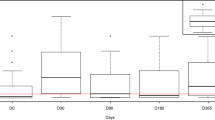Abstract
The aims of this study were to investigate various factors associated with protective anti-rabies antibody status (0.5 EU/ml) in vaccinated pet dogs and anti-rabies antibody status in unvaccinated stray dogs. One hundred and seven serum samples were collected from vaccinated pet dogs, out of these 58 (62.36 %) dogs showed antibody titre above 0.5 EU/ml. All the dogs were divided into different groups based on age, sex, breed, vaccine brand and time of vaccination after last vaccine to assess the relationship of these factors with vaccinal immune response. One way analysis of variance was performed in graphpad prism software to check the effect of all these factors. Statistical analysis of ELISA titres of pet dog serum samples suggested that age, sex, breed and vaccine brands have no significant effect on the anti-rabies antibody titres. To check anti-rabies antibody status in stray dogs 53 serum samples were collected and only one out of 53 (1.88 %) stray dogs showed anti-rabies antibody titre above 0.5 EU/ml indicating susceptibility to rabies infection and thereby posing possible threat to surrounding human and animal populations.
Similar content being viewed by others
References
Aiyedun JO. Community-based investigation of rabies antibody profile of dogs and control in Ilorin, Kwara state. J Environ Issues Agric Dev Ctries. 2013;5(2):51–5.
Berndtsson LT, Ann-Kristin JN, Esteban R, Berndt K. Factors associated with the success of rabies vaccination of dogs in Sweden. Acta Vet Scand. 2011;53:22.
Chappuis G. Neonatal immunity and immunisation in early age: lessons from veterinary medicine. Vaccine. 1998;16(14):1468–72.
Crick J. The vaccination of man and other animals against rabies. Postgrad Med J. 1973;49:551–64.
Cox JH, Dietzschold B, Schneider LG. Rabies virus glycoprotein II: biological and serological characterization. Infect Immun. 1977;16(3):754–9.
Jakel V, König M, Cussler K, Hanschmann K, Thiel HJ. Factors influencing the antibody response to vaccination against rabies. Dev Biol. 2008;131:431–6.
Jayakumar R. Elimination of rabies in dogs is the optimal control method for prevention of rabies in humans. Apricon. 2009;16–18.
Kennedy LJ, Lunt M, Barnes A, McElhinney L, Fooks AR, David NB, William ERO. Factors influencing the antibody response of dogs vaccinated against rabies. Vaccine. 2007;25:8500–7.
Kim N, Lee S, Seo M, Kim D, Lee J, Kwak D. Serologic detection of antibodies agains rabies virus in dogs from animal shelters in Seoul, South Korea. J Anim Vet Adv. 2013;12(6):721–5.
Knobel DL, Cleavel S, Coleman PG, Fèvre EM, Meltzer MI, Miranda MEG, Shaw A, Zinsstag J, Meslin FX. Re-evaluating the burden of rabies in Africa and Asia. World Health Org. 2005;83:60–368.
Mansfield KL, Burr PD, Snodgrass DR, Sayers R, Fooks AR. Factors affecting the serological response of dogs and cats to rabies vaccination. Vet Rec. 2004;154(14):423–6.
Martinez L. Global infectious disease surveillance. Int J Infect Dis. 2000;4:222–8.
Meslin FX, Fishbein DB, Matter HC. Rationale and prospects for rabies elimination in developing countries. In: Rupprecht CE, Dietzschold B, Koprowski H, editors. Lyssaviruses. Berlin: Springer; 1994. p. 1–26.
Muller TF, Peter S, Vos AC, Thomas SD, Wenzel A, Neubert M. Effect of maternal immunity on the immune response to oral vaccination against rabies in young foxes. AJVR. 2001;62(7):1154–8.
Nagarajan T, Nagendrakumar SB, Mohanasubramanian B, Rajalakshmi S, Hanumantha NR, Ramya R, Thiagarajan D, Srinivasan VA. Phylogenetic analysis of nucleoprotein gene of dog rabies virus isolates from Southern India. Genet Evol. 2009;9:976–82.
Ogawa T, Gamoh K, Kanda K, Suzuki T, Kawashima A, Narushima R, Shimazaki T. Rabies immune status of dogs brought into the Hyogo Prefecture Animal Well-being Center, Japan. J Vet Med Sci. 2009;71:825–6.
Olugasa OO, Aiyedun JO, Emikpe BO. Prevalence of antibody against rabies among confined, free roaming and stray dogs in a transit city of Nigeria. Vet Ital. 2011;47(4):453–60.
Singh MP, Goyal K, Majumdar M, Ratho RK. Prevalence of rabies antibodies in street and household dogs in Chandigarh, India. Trop Anim Health Prod. 2011;43:111–4.
Shyamsundar KA. M.V.Sc. Thesis submitted to College of Karnataka Veterinary science and Fisheries on the topic of “Studies on status of anti-rabies vaccinal antibodies in dogs”; 2014.
Warrell MJ, Warrell DA. Rabies and other lyssaviruses disease. Lancet. 2004;363:959–69.
WHO. Assessing the burden of rabies in India. WHO sponsored national multicentric rabies survey. Association for prevention and control of rabies in India; 2004.
WHO. Animal-bites. Fact sheet. http://www.who.int/mediacentre/factsheets/fs373. Accessed 2013.
Author information
Authors and Affiliations
Corresponding author
Additional information
Part of M.V.Sc. thesis submitted by Bhumika F. Savaliya to AAU, Anand.
Electronic supplementary material
Below is the link to the electronic supplementary material.
Rights and permissions
About this article
Cite this article
Savaliya, B.F., Mathakiya, R.A., Bhanderi, B.B. et al. Evaluation of phenotypic factors for anti-rabies antibody in vaccinated pet dogs. VirusDis. 26, 282–287 (2015). https://doi.org/10.1007/s13337-015-0284-6
Received:
Accepted:
Published:
Issue Date:
DOI: https://doi.org/10.1007/s13337-015-0284-6




